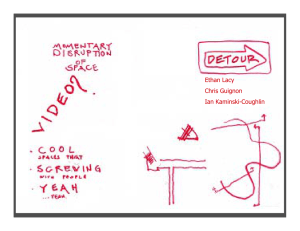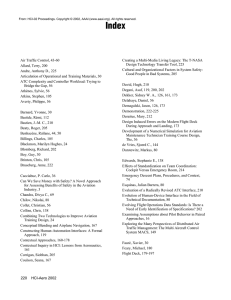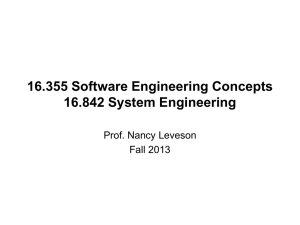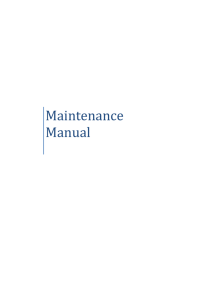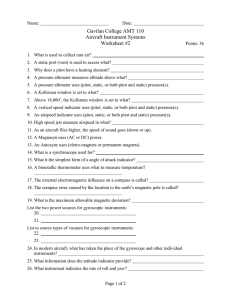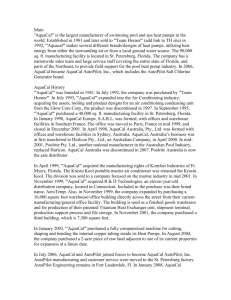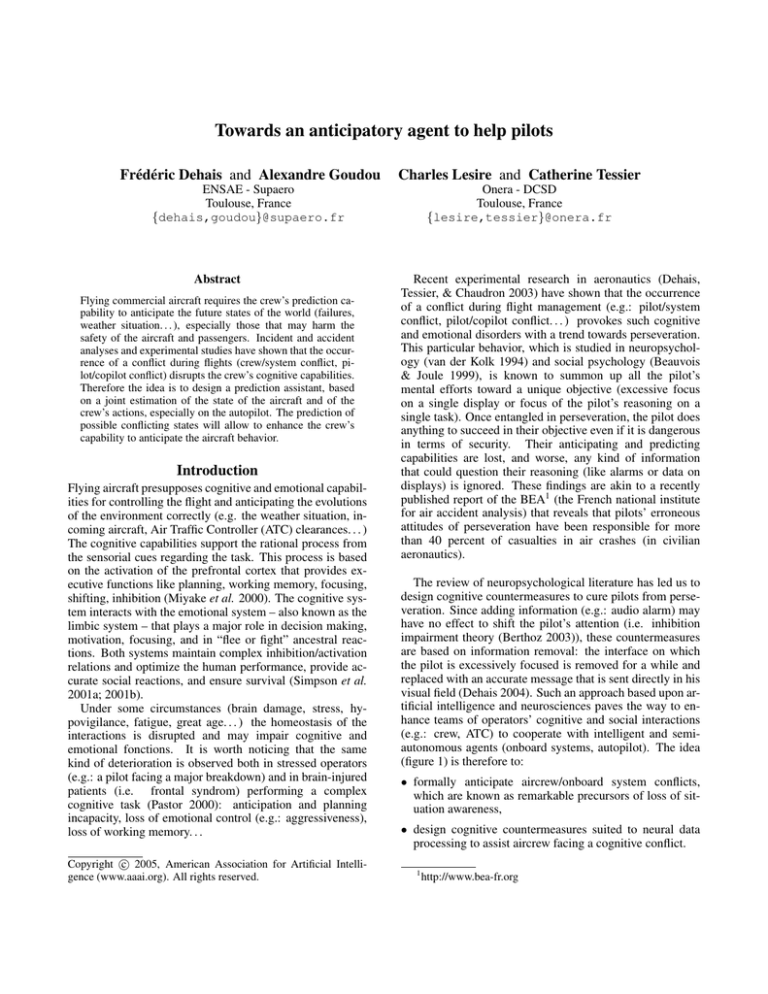
Towards an anticipatory agent to help pilots
Frédéric Dehais and Alexandre Goudou
Charles Lesire and Catherine Tessier
ENSAE - Supaero
Toulouse, France
{dehais,goudou}@supaero.fr
Onera - DCSD
Toulouse, France
{lesire,tessier}@onera.fr
Abstract
Flying commercial aircraft requires the crew’s prediction capability to anticipate the future states of the world (failures,
weather situation. . . ), especially those that may harm the
safety of the aircraft and passengers. Incident and accident
analyses and experimental studies have shown that the occurrence of a conflict during flights (crew/system conflict, pilot/copilot conflict) disrupts the crew’s cognitive capabilities.
Therefore the idea is to design a prediction assistant, based
on a joint estimation of the state of the aircraft and of the
crew’s actions, especially on the autopilot. The prediction of
possible conflicting states will allow to enhance the crew’s
capability to anticipate the aircraft behavior.
Introduction
Flying aircraft presupposes cognitive and emotional capabilities for controlling the flight and anticipating the evolutions
of the environment correctly (e.g. the weather situation, incoming aircraft, Air Traffic Controller (ATC) clearances. . . )
The cognitive capabilities support the rational process from
the sensorial cues regarding the task. This process is based
on the activation of the prefrontal cortex that provides executive functions like planning, working memory, focusing,
shifting, inhibition (Miyake et al. 2000). The cognitive system interacts with the emotional system – also known as the
limbic system – that plays a major role in decision making,
motivation, focusing, and in “flee or fight” ancestral reactions. Both systems maintain complex inhibition/activation
relations and optimize the human performance, provide accurate social reactions, and ensure survival (Simpson et al.
2001a; 2001b).
Under some circumstances (brain damage, stress, hypovigilance, fatigue, great age. . . ) the homeostasis of the
interactions is disrupted and may impair cognitive and
emotional fonctions. It is worth noticing that the same
kind of deterioration is observed both in stressed operators
(e.g.: a pilot facing a major breakdown) and in brain-injured
patients (i.e. frontal syndrom) performing a complex
cognitive task (Pastor 2000): anticipation and planning
incapacity, loss of emotional control (e.g.: aggressiveness),
loss of working memory. . .
c 2005, American Association for Artificial IntelliCopyright gence (www.aaai.org). All rights reserved.
Recent experimental research in aeronautics (Dehais,
Tessier, & Chaudron 2003) have shown that the occurrence
of a conflict during flight management (e.g.: pilot/system
conflict, pilot/copilot conflict. . . ) provokes such cognitive
and emotional disorders with a trend towards perseveration.
This particular behavior, which is studied in neuropsychology (van der Kolk 1994) and social psychology (Beauvois
& Joule 1999), is known to summon up all the pilot’s
mental efforts toward a unique objective (excessive focus
on a single display or focus of the pilot’s reasoning on a
single task). Once entangled in perseveration, the pilot does
anything to succeed in their objective even if it is dangerous
in terms of security. Their anticipating and predicting
capabilities are lost, and worse, any kind of information
that could question their reasoning (like alarms or data on
displays) is ignored. These findings are akin to a recently
published report of the BEA1 (the French national institute
for air accident analysis) that reveals that pilots’ erroneous
attitudes of perseveration have been responsible for more
than 40 percent of casualties in air crashes (in civilian
aeronautics).
The review of neuropsychological literature has led us to
design cognitive countermeasures to cure pilots from perseveration. Since adding information (e.g.: audio alarm) may
have no effect to shift the pilot’s attention (i.e. inhibition
impairment theory (Berthoz 2003)), these countermeasures
are based on information removal: the interface on which
the pilot is excessively focused is removed for a while and
replaced with an accurate message that is sent directly in his
visual field (Dehais 2004). Such an approach based upon artificial intelligence and neurosciences paves the way to enhance teams of operators’ cognitive and social interactions
(e.g.: crew, ATC) to cooperate with intelligent and semiautonomous agents (onboard systems, autopilot). The idea
(figure 1) is therefore to:
• formally anticipate aircrew/onboard system conflicts,
which are known as remarkable precursors of loss of situation awareness,
• design cognitive countermeasures suited to neural data
processing to assist aircrew facing a cognitive conflict.
1
http://www.bea-fr.org
Figure 1: Ghost: estimate, detect, help.
Pilots, autopilot and shared authority
Modern commercial planes can be considered controlled
by two agents: the human agent (the crew) and the artificial agent (the autopilot and the Flight Management System (FMS)). The flight is realized under the interaction of
another human agent: the ATC, who can order any modifications for the flight: altitude clearance, heading, holding
pattern, airport approach.
Modern autopilots and FMSs are designed to increase the
flight safety by reducing the aircrew workload. They are
complex state-machines, able to manage a preprogrammed
flight from takeoff to landing with very few crew actions
during the flight. They manage the flight in the ”lateral
mode” (i.e. Navigation) and in the ”vertical mode” (i.e. optimizing the performance during the Climb, Cruise and Descent phases of the flight), but the crew can select some flight
parameters (for example the Heading in the ”lateral mode”
or the Vertical Speed in the ”vertical mode”...), in order to
follow the ATC’s instructions.
The human agent can always have the priority on the artificial agent. The crew can always disengage the autopilot,
reconfigure the FMS or go ”back to the basics”. However,
in particular conditions (protection of the flight domain), the
autopilot makes a ”mode reversion”, i.e. an automatic state
modification to anticipate an overspeed or underspeed and,
if the speed limitation is reached, the autopilot automatically
disengages.
It is easy to understand that such complex interactions
may induce conflicts, especially during ”abnormal operations”.
Let us review three real incidents for which we have identified three kinds of conflicts between the human and the
artificial agents:
1. Automatic disconnection not perceived by the crew: the
autopilot sent the control of the flight back to the crew,
while the aircrew still thought that the autopilot is in control. Every disconnection of the autopilot is signaled by an
audio warning and a visual warning on the cockpit alarm
display. But when the autopilot is disconnected after an
overspeed for example, the overspeed audio warning has
priority on the autopilot disengagement audio warning.
The crew applied the overspeed procedure, but did not
notice the autopilot disconnection (BEA 2002 2003a).
2. Inconsistent orders to the autopilot: an order can be consistent in some phases of the flight, but not consistent in
other phases. In this particular case, the autopilot was
in the approach mode (APPR), at 1200 ft Above Ground
Level (AGL), the pilot not flying (PNF) selected a new
waypoint on his MCDU (Multifunction Control Display
Unit). At this time, the autopilot mode changed from
APPR to NAV (managed navigation) and V/S (vertical
speed, automatically set at the current vertical speed, here
-1000 ft/min). The crew did not immediately perceive
the changes and the plane leveled off around 400 ft AGL
(BEA 2002 2003b).
3. The autopilot and the crew have different goals: the selection of a specific mode by the crew has unexpected consequences on the autopilot behavior. A typical example of
this kind of conflict is the inadequate selection of the Go
Around altitude on the autopilot interface (FCU) when the
autopilot is in the Glide/Slope (G/S) mode, i.e. descending on the ILS path. At this time, if the plane reaches a too
high speed due to its configuration (for example during
flaps extension) the autopilot automatically discards the
G/S mode and tries to reach the target altitude. The plane
climbs whereas the crew wish to land (Crow, Javaux, &
Rushby 2000).
As a matter of fact, conflicts stem from a bad design of
the shared authority between the crew and the autopilot.
Generally speaking shared authority is the way the
decision functions are shared out among the various agents
involved in a mission. Most of the time, shared authority
implies that artificial (i.e. non-human) agents are equipped
with a certain level of “autonomy” with regard to the
particular decisional agents the human agents are – this is
the case for example in collaborative control (Fong, Thorpe,
& Baur 2003) or in mixed-initiative control (Murphy 2000)
– as people can provide valuable input that improves the
performance of the system (Scerri et al. 2003). It is worth
noticing however that autonomy is neither an end in itself
nor an absolute notion (Steels 1995), but aims at meeting
specific operational requirements within a well-defined
context. Consequently, autonomy necessarily implies a
shared authority between agents at a certain time scale and
at a certain decisional level. As a matter of fact, autonomy
and shared authority are dual concepts for the same notion.
The key issue of shared authority is situation assessment
i.e:
1. Maintaining the human agents’ situation awareness (Endsley 2000; Nofi 2000) i.e. their understanding of the current state of the automatisms, of the environment, of the
(flight)plan execution, and of how the various states are
likely to evolve in the near future. The situation awareness has to be:
• suited to the operators’ roles within the mission,
• consistent with the current automatism / autonomy levels of the artificial agents (i.e. consistent with the operators’ current control level on the artificial agents),
• consistent with the current mission phase (Murphy
2004),
so as to enable the operators to send relevant orders.
2. Maintaining situation assessment for the artificial agents,
i.e. the current models and predictions the agents have for
themselves, for the environment, for the execution state of
the (flight)plan, for the operators’ actions. The situation
assessment has to be:
• suited to the current automatism / autonomy levels of
the artificial agents,
• consistent with the current mission phase,
so as to allow the automatic triggering of relevant actions.
Therefore intelligibility must be mutual. For instance, the
task context must not be lost when an automatism (the autopilot) cedes control to the human agent (the crew), so as to
prepare for a return to the automatism control (Brookshire,
Singh, & Simmons 2004).
What is suggested to guarantee an intrinsic consistency
of situation assessment, is a way to estimate and predict the
states of both human operators and automatisms through a
unified hybrid model, so that any agent might keep a relevant and consistent awareness / knowledge of the situation through a common reference and switch authority levels
with full knowledge of the facts. This approach is significant
for the autopilot / crew system as the autopilot is designed in
such a way that (1) its communication with the crew is quite
poor and (2) the details of shared authority are not always
clear to the crew.
A prediction assistant
The aim of the system presented in this paper is to help both
automatic and human agents estimating and predicting the
aircraft behavior. The estimation is performed using (1) the
particle Petri net model (Lesire & Tessier 2005) to represent
the aircraft–pilot interactions and evolutions and (2) classical Petri nets to represent the autopilot functioning. The estimation principle allows inconsistencies to be detected and
studied, thus helping the crew understanding the autopilot
behavior and anticipating possibly dangerous situations.
Petri nets (refresher)
A Petri net < P, T, F, B > is a bipartite graph with two
types of nodes: P = {p1 , . . . , , pi , . . . , pm } is a finite set
of places; T = {t1 , . . . , tj , . . . , tn } is a finite set of transitions (Petri 1962; David & Alla 2005). Arcs are directed and
represent the forward incidence function F : P × T → N
and the backward incidence function B : P × T → N respectively. An interpreted Petri net is such that conditions
and events are associated with places and transitions. When
the conditions corresponding to some places are satisfied,
tokens are assigned to those places and the net is said to be
marked. The evolution of tokens within the net follows transition firing rules. Petri nets allow sequencing, parallelism
and synchronization to be easily represented.
Predicting the aircraft state. . .
Estimating and predicting the aircraft state and the crew’s
actions are performed using a hybrid model whose numerical part represents the continuous evolution of the aircraft
parameters and the symbolic part represents the crew’s
actions on the aircraft and on the autopilot.
Let us consider the Climb phase. The particle Petri net of
this phase is shown in figure 2. The first step consists of a
climb (FL %) and acceleration (S %) of the aircraft while
the pilot has to set the gear up, set the FCU altitude to flight
level 210 (FL 210), engage autopilot 1 (AP1) and mode
thrust/climb (THR/CLB). When the 300kt-speed is reached
(S≥300), the aircraft goes on climbing (FL %) at a 300ktspeed (S 300). When FL 210 is reached, the Climb phase
is completed, and the aircraft enters the next phase (Cruise).
If an overspeed warning appears (coming from the autopilot
Petri net), the procedure is to set speed brakes (SPD BRK).
Then the speed decreases (S &), and when a “normal” situation is recovered (S ≤ 300), the pilot has to engage the
autopilot again (AP 1).
Tokens π (1) , π (2) , δ (1) represent the current estimated situation:
• particles π (1) = {Speed260, F L180, Heading53 . . . }
and π (2) = {Speed270, F L185, Heading53 . . . } are
two probable numerical vectors corresponding to the estimated aircraft parameters;2
• δ (1) = {GearU p, F L210} is a possible symbolic vector
representing the aircraft (and autopilot) configuration.
Prediction is achieved through the computation of the
reachable markings of the Petri net, i.e. the set of expected states. Let us consider the initial marking (the current situation) the Petri net on figure 2. The possibly future situations are those where the crew has engaged AP1
and mode THR/CLB, and where the aircraft parameters are
predicted according to differential equations associated to
places “climb and accelerate” and “climb” respectively (figure 3).
Correction is achieved through the comparison and selection of the “best” matchings between the predicted tokens
and a new observation. The numerical correction consists
in weighting the particles according to the noisy numerical
measure. The symbolic correction consists in ranking the
configurations according to a partial preorder. Finally, corrected particles and configurations are matched. This hybrid
matching allows to:
• resample a marking, when it corresponds to both numerical and symbolic measures and is consistent: the particles
are resampled and the configuration is kept for the next
prediction step;
2
For the sake of clarity only two particles are considered in this
paper. In fact the higher the number of particles, the better the
representation of the uncertainty on the aircraft state.
Figure 3: Marking of predicted situations.
Figure 2: Particle Petri net for the Climb phase: numerical places (in lite) represent the continuous evolution of the
aircraft state according to differential equations; symbolic
places (in bold) represent the discrete evolution of the aircraft configuration according to the crew’s actions.
• discard a marking, when it does not correspond to the
measures;
• analyse a marking when it corresponds to the measures
but is inconsistent (it does not correspond to a reachable
marking of the Petri net).
The next section introduces the overspeed detection and
its relation to prediction and conflict detection. Then the
case of inconsistent matchings is detailed, as it may reveal
possible conflictual situations.
. . . and detecting conflicts
The Petri net of figure 4 corresponds to the Pilot/Autopilot conflict detection process. The initial place
(No Potential Conflict) represents the “normal” state, i.e.
when the autopilot controls the aircraft. The next two places
represent two possible states of potential conflict: (1) autopilot automatic disconnection (AP OFF transition has fired)
and (2) autopilot mode reversion (AP Reversion transition
has fired). When one of these transitions fires, two processes
are run: a timer and a conflict detection process.
Figure 4: Autopilot Petri net (implemented with ProCoSA
(Barrouil & Lemaire 1999)).
Detecting inconsistencies (and consequently conflicts) in
the crew’s actions or in the aircraft state is based on the estimation principle presented in the previous section. Let us
consider the following scenario: during the climb to flight
level 210, a jet stream makes the aircraft accelerate. The result is an overspeed that disengages the autopilot. A conflictual situation may come from: (1) the crew do not notice the
autopilot is not engaged any longer, or (2) the crew engage
the autopilot, but if the target altitude (level 210) has been
overshot, the autopilot mode switches to V/S and the aircraft
keeps on climbing indefinitely (whereas it should descend to
reach level 210). The current estimated situation is marking
(π (2) , δ (3) ) within figure 3 Petri net. The overspeed event
is caught by the autopilot Petri net (AP OFF transition fires,
figure 4), that enables the overspeed transition of the particle Petri net of the Climb phase. Then the estimation process
goes on considering the overspeed procedure. Let the predicted situation be the marking shown in figure 5, where the
tokens values are such that
• within particle π (1) , the speed is 280kt, and FL 215;
• within particle π (2) , the speed is 300kt, and FL 220;
• within configuration δ (1) , speed breaks are set, and AP 1
disengaged;
• within configurations δ (2) and δ (3) , the AP is engaged in
mode climb (CLB).
Vertical Speed is selected. Particle π (2) corresponds to the
numerical observation (numerical correction), but no predicted configuration corresponds to the symbolic observation. Therefore marking (π (2) , ∅) is inconsistent, and a
Conflict is sent to the autopilot Petri net.
Finally, when a conflict is detected by the estimation process, the Conflict transition within the autopilot Petri net
fires and the Agent Conflict state is reached. At this time,
the purpose is to send cognitive countermeasures to enhance
the crew’s capability to anticipate the behavior of the aircraft.
Further research
The next step will consist in an empirical validation of the
predicting tool with pilots in the 3-axis Airbus flight simulator at Supaero. The idea is to conduct experiments where
aircrews will be placed in conflictual situations with the automatic systems.
A first challenge of these experiments is to test the tool capability to anticipate real pilot/autopilot conflicts: both objective (flight parameters analysis) and subjective (debriefing with pilots) methods will be used to assess its effectiveness . The second challenge is to determine on which display
the countermeasures should be sent to assist the crew facing
the conflict. The idea is to use an eye-tracker to analyse gaze
motion and fixation points in the cockpit according to each
flight phase.
Eventually, another interesting challenge for air safety is
the online detection of cognitive deterioration like perseveration: a solution could consist in an empirical integrative
approach including stress physiological indicators (occulomotricity parameters, electro dermal response, voice tone),
and the use of electro encephalogram. These physiological
parameters are planned to be integrated in the prediction tool
so as to anticipate conflicts as early as possible.
References
Figure 5: Predicted states after the overspeed event.
The predicted markings are then updated according to the
correction step. Three cases can be pointed out:
• The timer goes out while no inconsistent marking has
been detected, and
1. the corrected states (according to the measures) do not
mark the “overspeed procedure” part of the Petri net:
the end Timer transition (figure 4) fires and the Petri
net goes back to a “normal” situation;
2. an estimated state is marking the “overspeed procedure” part of the Petri net: δ (1) situation reveals that
the crew may have forgotten to engage the AP, which is
considered as a Conflict;
• Correction results in an inconsistent marking: the symbolic observation is such that the AP is engaged and mode
Barrouil, C., and Lemaire, J. 1999. Advanced real-time
mission management for an AUV. In Symposium on Advanced Mission Management and System Integration Technologies for Improved Tactical Operations.
BEA.
2002-2003a.
Débrayage du pilote automatique (in French).
www.beafr.org/itp/events/debrayagpa/debrayagpa.html.
BEA.
2002-2003b.
Ecart de trajectoire
(in
French).
www.beafr.org/itp/events/ecartdetrajectoire/ecartdetrajectoire.html.
Beauvois, J., and Joule, R. 1999. A radical point of view
on dissonance theory. In Harmon-Jones, E., and Mills, J.,
eds., Cognitive Dissonance: Progress on a Pivotal Theory
in Social Psychology.
Berthoz, A. 2003. La décision (in French). Odile Jacob.
Brookshire, J.; Singh, S.; and Simmons, R. 2004. Preliminary results in sliding autonomy for coordinated teams. In
Interaction between humans and autonomous systems over
extended operations, AAAI Spring Symposium, 127–132.
Crow, J.; Javaux, D.; and Rushby, J. 2000. Models and
mechanized methods that integrate human factors into automation design. In HCI-AERO’00, 163–168.
David, R., and Alla, H. 2005. Discrete, Continuous, and
Hybrid Petri Nets. Springer.
Dehais, F.; Tessier, C.; and Chaudron, L. 2003. Ghost:
experimenting conflicts countermeasures in the pilot’s activity. In IJCAI’03.
Dehais, F. 2004. Modélisation des conflits dans l’activité
de pilotage (in French). Ph.D. Dissertation, ENSAE - Supaero, Toulouse, France.
Endsley, M. 2000. Theoretical underpinnings of situation
awareness: a critical review. In Endsley, M., and Garland,
D., eds., Situation awareness analysis and measurement.
Lawrence Erlbaum Associates.
Fong, T.; Thorpe, C.; and Baur, C. 2003. Multi-robot remote driving with collaborative control. IEEE Transactions
on Industrial Electronics 50(4).
Lesire, C., and Tessier, C. 2005. Particle Petri nets for aircraft procedure monitoring under uncertainty. In ATPN’05.
Miyake, A.; Friedman, N.; Emerson, M.; Witzki, A.; and
Howerter, A. 2000. The unity and diversity of executive
functions and their contribution to complex ”frontal lobe”
tasks: a latent variable analysis. Cognitive Psychology 41.
Murphy, R. 2000. Introduction to AI Robotics. The MIT
Press.
Murphy, R. 2004. Human-robot interaction in rescue
robotics. IEEE Systems, Man and Cybernetics Part C: Applications and Reviews, special issue on Human-Robot Interaction 34(2).
Nofi, A. A. 2000. Defining and measuring shared situation
awareness. Technical Report CRMD0002895.A1/Final,
Center for Naval Analysis.
Pastor, J. 2000. Cognitive performance modeling - assessing reasoning with the EARTH methodology. In COOP’00.
Petri, C. 1962. Kommunikation mit Automaten. Ph.D.
Dissertation, Institut für Instrumentelle Mathematik, Bonn,
Germany.
Scerri, P.; Pynadath, D.; Johnson, L.; Rosenbloom, P.; Si,
M.; Schurr, N.; and Tambe, M. 2003. A prototype infrastructure for distributed robot-agent-person teams. In
AAMAS’03, 433–440.
Simpson, J.; Drevets, W.; Snyder, Z.; Gusnard, D.; and
Raichle, M. 2001a. Emotion-induced changes in human
medial prefrontal cortex: I. During cognitive task performance. PNAS 98(2).
Simpson, J.; Drevets, W.; Snyder, Z.; Gusnard, D.; and
Raichle, M. 2001b. Emotion-induced changes in human
medial prefrontal cortex: II. During anticipatory anxiety.
PNAS 98(2).
Steels, L. 1995. When are robots intelligent autonomous
agents? Robotics and Autonomous Systems 15(1-2):3–9.
van der Kolk, B. 1994. The body keeps the score: memory and the evolving psychobiology of post traumatic stress
disorder. Harvard Review of Psychiatry 1.

